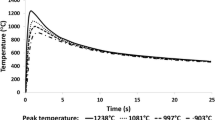Abstract
The development of lean alloyed high strength steels of 500–800 MPa yield strength has shown that conventional welding processes and procedures can result in significant HAZ softening. Previous work on the significance of softened HAZ regions is reviewed and a recent investigation will be described in which the importance of HAZ softening in a 550 MPa QT steel has been assessed using fracture toughness and surface notched mini-wide plate tests. Submerged arc welds at 2.4 kJ/mm were made using consumables of different strength levels, which both overmatched and undermatched the parent plate yield strength. Softening of approximately 45HV10 was observed in the HAZ and the CTOD fracture toughness tests showed that the transition temperature of the HAZ for the overmatched weld was 60°C higher than the equivalent HAZ in the undermatched weld. The work shows that overmatching weld metals can concentrate strain into softened HAZs and if flaws are close to the HAZ, low cleavage resistance can be measured. This was confirmed by the results of the mini-wide plate tests. The implications of these findings are discussed in the context of welded steels of 500–800 MPa yield strength.
Similar content being viewed by others
References
Denys, R., “The effect of HAZ softening on the fracture characteristics of modern steel weldments and the practical integrity of marine structures made by TMCP steels”, EVALMAT 89, Kobe, Japan, 20–23 November 1989, ISIJ 1989, vol.2, p. 1013.
Lundin, C. D., Gill, T. P. S. and Qiao, C. Y., “Heat affected zones in low carbon microalloyed steels”. Recent trends in Welding Science and Technology Proceedings, 2nd International Conference, Gatlinburg, May 1989. Eds S. A. David, J. M. Vitek, A. S. M. International 1990.
Shiga, C., “Effects of steelmaking, alloying and rolling variables on the HAZ structure and properties in microalloyed plate and line pipe”. The Metallurgy, Welding and Qualification of Microalloyed (HSLA) Steel Weldments Proceedings International Conference, Houston, November 1990. Ed J. T. Hickey etc.al. AWS 1990.
Komizo, Y., “Performance of welded joints in TMCP steel plates”. Welding International 1991, 5 (8), p. 598.
Yurioka, N., “TMCP steels and their welding”. Welding in the World 1995, 35 (6), p. 375.
Otani, T., Tsukamoto, S., Arakane, G., Ohmori, A., “HAZ characteristics of Ultra-fine grained high strength steel welded by high power CO2 Laser”. 7th International Welding Symposium, November 2001, Kobe, JWS p. 773.
Ito, R., Hiraoka, K., Kosugai, T., Shiga C, “Microstructural characteristics of welding HAZ in Ultra-fine ferrite grained steel”, Ibid.
SINTAP — “Structural Integrity Assessment Procedures for European Industry” Final Procedure, November 1999, Brite Euram Project BD95-1426. Contract BRPR-CT95–0024.
Harrison, P. L., “Weld Strength Mismatch Effects — multipass weld evaluation” SINTAP report BS/24, March 1999.
Author information
Authors and Affiliations
Rights and permissions
About this article
Cite this article
Pisarski, H.G., Dolby, R.E. The Significance of Softened HAZs in High Strength Structural Steels. Weld World 47, 32–40 (2003). https://doi.org/10.1007/BF03266387
Published:
Issue Date:
DOI: https://doi.org/10.1007/BF03266387




